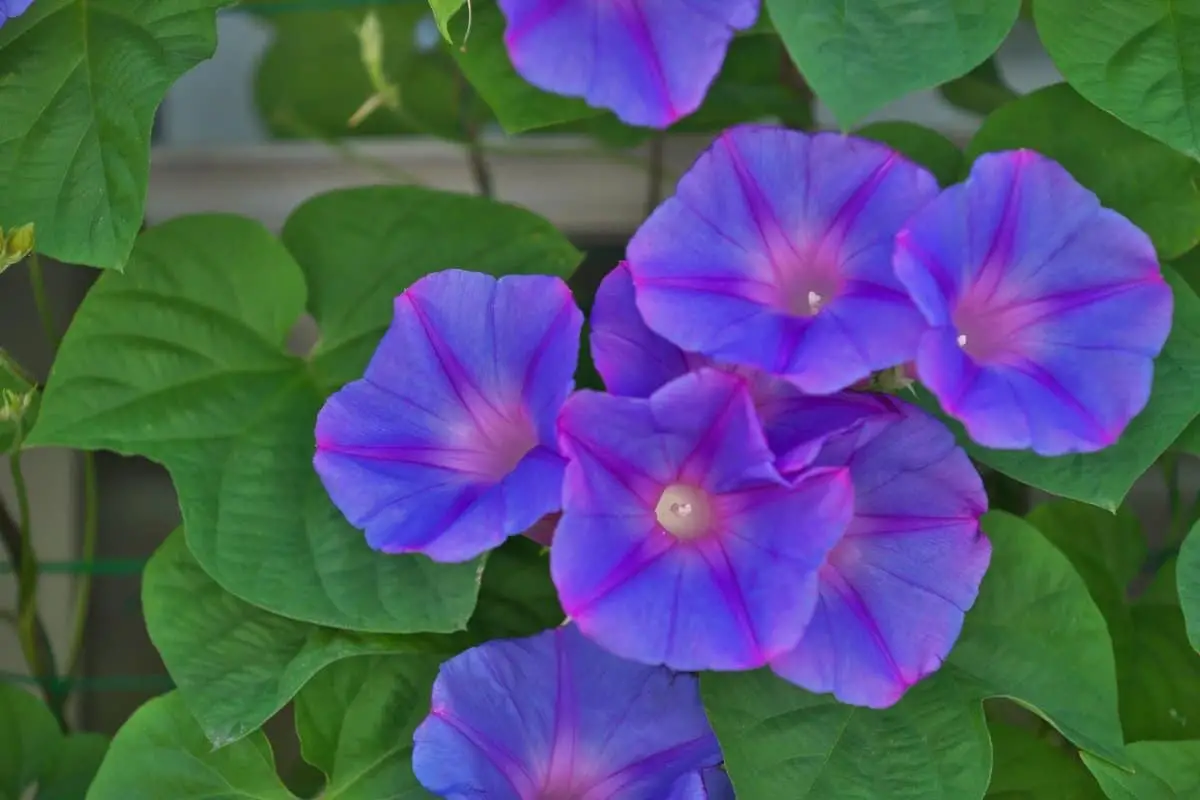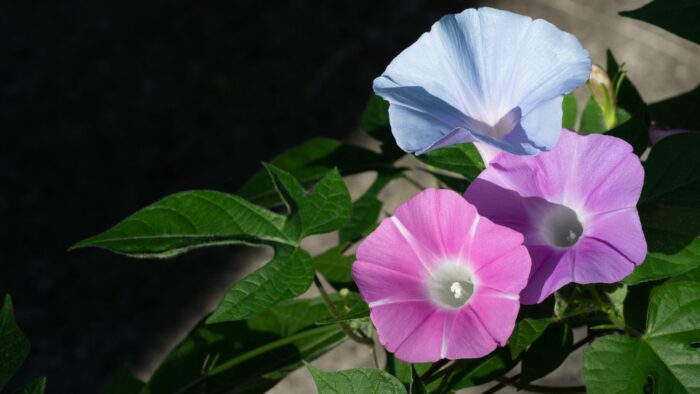Last Updated on April 6, 2023 by Griselda M.
Do morning glories come back is the question that we answer in this blog post. Aside from that, this article has essential information for both established and avid gardeners. There is something magical about morning glories that makes many gardeners grow them, but are morning glories annuals or perennials?
These flowers bloom gloriously in the morning and then swirl closed at the end of the day. That’s what makes morning glories different from others, and they are irresistible.
Morning glory vines bring an old-fashioned charm and a quaint cottage feeling to any home or garden. These flowers are not for every garden – they are best for someone who will take care of them because they can be quite aggressive. Morning glories will come to your windows and doors if you let them, but to keep these vines in check, prune them up to 3 feet tall each year in January.
If you have a place where they can run wild over an arbor, a fence, or a pergola, it’s best to grow them there. If you are up for the challenge of growing them, let’s learn how to grow these flowers.
Are Morning Glories Perennials Or Annuals?
Morning glories are grown as either annuals or perennials. The moonflower (Ipomoea Alba) are perennial in the USDA hardiness zones 9 through 11. The common morning glory (Ipomoea Tricolor) is hardy and does well as a perennial in USDA zones 10 and 11.

So Do Morning Glories Come Back Year After Year?
In USDA hardiness zones 10 and 11, these flowers grow as perennials. During winter or early spring, cut back your morning glory vines as perennials up to about 6 inches above the ground. The cutting removes old and tired growth and encourages them to come back strong and vigorous.
What If They Don’t Grow Back?
If your morning glories are annuals, remove them at the end of their blooming period in summer. To start new plants, sow your morning glories seeds in the same location after the danger of frost has passed. Cutting the vines after blooming opens up the garden for other plants to take center stage.
Medicinal and Ritual Use
Did you know morning glory has been used as a laxative in Asian and Mesoamerican countries for ages?
It is used in making tea concocted from its roots as a diuretic and expectorant. Tea is also brewed from the dry leaves and used to treat headaches by herbal healers.
Seeds from this plant are consumed as a hallucinogenic substance due to a compound called LSA, similar to LSD. Mesoamerican Indians use the seeds to enter trances and alter ritualistic purposes.

Planting Instructions for Morning Glories Perennials Or Annuals
-
Sowing
Morning glories easily grow from seed. You can start them indoors at least 4 to 6 weeks before the last spring frost. If you sow them directly into the garden, plant them after any threat of frost has passed. Ensure the ground is warm, at least up to 64 degrees F.
-
Planting site
Choose a planting site that gets plenty of sunlight. The morning glory plants tolerate partial sun and shade, but they have to bloom in full sun. Because they grow so fast, please choose an area that allows them to grow up to maturity. These flowers will self-seed if allowed to do so; be sure to grow them in a place where you can access them before cutting back spent blooms before seeding. Also, consider your neighbor’s yard or garden before planting to ensure seeds do not fall into their garden.
How to Plant
1. If growing from seed…
File your seeds to break the outer shell before planting, and soak them for 24 hours; this helps with germination. Cover lightly with soil at least ¼ to ½ inch of soil and water thoroughly.
2. When transplanting…
Be careful not to disturb the roots when transplanting. Water them deeply after transplanting for several days to help the roots get established in their new home. Use peat or other disintegrating pots planted directly in the soil to eliminate stress on the root system. Once established, morning glories grow very fast, up to 12 feet tall or more in one season.
Seed Needs, Heavenly Blue Morning Glory (Ipomoea Tricolor)
Morning Glories Perennials Or Annuals Care
-
The soil. Morning glories thrive in moderately fertile, well-drained soil that is consistently moist until the plant is well-established. Adult plants are not as picky about their soil and can withstand poor, dry soil, unlike the young ones.
-
Watering. Water your plants freely during the growing season. Water once or twice a week during dry periods, but adult morning glory plants can tolerate drier conditions. Cut back watering during winter.
-
Amendments & fertilizer. Although not necessary, you can apply a balanced liquid fertilizer each month during the growing season. Ensure you don’t over-fertilize, as this can produce more foliage than blooms.
-
Pruning: These flowers do not require pruning. But, to prevent unwanted self-seeding, you should remove old flowers before they form seedpods.
Diseases and Pests
Morning glory flowers are not generally affected by disease or pests but can occasionally be attacked by rust, white blister, fungal leaf spot, stem rot, or wilt. They are also bothered by leaf miners, aphids, spider mites, and caterpillars.
Best Places to Plant Your Morning Glories
-
- They are best grown to cover arches, trellises, pergolas, and fences.
- Use morning glories to cover an unsightly area or create a colorful wall.
- Grow them as a fashion in a living fence, porch, or deck railing.
- Plant your vines in containers and add a supporting trellis.
- Drape them out of a hanging basket; they will twine up the hangers and look beautiful.
- Grow them responsibly in areas where reseeding is acceptable, but also control them.
Morning Glory Growth Stages
When it comes to morning glory growth stages, these plants are quite interesting. These spreading vines are quite eye-catching, especially when they are left to climb and grow. Their blooms also enhance any landscape or garden, so it is a benefit to have them as a part of any garden.
However, seeing that they can grow out of control, you should consider the space you have when planting them. This will save you a lot of trouble and reduce the work you would have to do to keep them tame. Listed below is an insight into the growing stages of morning glory plants.
Growth stages of morning glory plants:
- Emergence – After seeding, these plants emerge after about 75 growing degree days.
- Flower and seed production – This occurs after about 640 growing degree days. This happens after the emergence stage. However, although they may continue to grow, the first frost is likely to kill off the shoots.
- Seedlings – For the morning glory plant to become a perennial, the seeds would need to grow and develop for about 460 growing degree days. The time of the second year’s growth expectancy is reduced by a few weeks.
- Shoots – In the first year of growth, the dry weight of shoots is much lower. Thereafter, it can increase substantially over the next few years.
- Root growth – In morning glory plants, the root growth starts off slowly and incurs a lot of dry weight in the first year. Thereafter, it increases in dry weight just as the shoots do. However, the roots take half the time to increase.
What to Do with Morning Glories in the Fall?
Ever wondered what to do with morning glories in the fall? As mentioned above, these plants are perennials in USDA zones 10 to 11 and annuals in closer climates. For annuals, it is best to prune them to the ground after the blooming period comes to an end in the fall. Thereafter, new plants can be started in the season that follows. Listed below are a few tips about what to do with morning glories in the fall.
Tips:
- It is advisable to store morning glory seeds when you cut them back in the fall. You can keep the seeds in a ziplock bag, not forgetting to name and date the package so you know which flower plant it belongs to.
- When storing seeds, remember to dry the seeds and get rid of any air than is in the bag. You can then store it until spring.
- Seeing that morning glories are easy to maintain, if you opt not to cut them down in the fall, ensure that they are well watered, especially during dry episodes.
- To retain moisture and suppress weeds that may affect your morning glory plants, adding mulch around them is recommended. This is especially true during the fall season.
- If you want to keep the plant as is, then you can stop it from reseeding. All you have to do is to remove any old flowers before they become seedpods. This will also result in more bloom production.
- Keep in mind that allowing the seeds to mature requires a lot of energy from your morning glories. This alone can flaw bloom production.
How to Propagate Morning Glory?
For both established and new gardeners, it is essential to know how to propagate morning glory if you want to grow thriving plants. Morning glory propagation is simple and easy, as these plants can be started from cuttings or seeds. Keep in mind that the best time to sow morning glory seeds is in the spring season. These stunning plants also favor tropical and sub-tropical climates as they thrive in them. Morning glory seed propagation takes about three to four months before flowers appear.
If you opt to propagate morning glory plants from cuttings, then doing so in the rainy season or late summer is advised. Both seed and cuttings will require the same type of potting mix for morning glories. To sow, you should choose a plant pot that has drainage holes or a germination tray. Then, you can add the ideal morning glory potting mix to the germination container and sow your seeds.
Remember to space them out at about 2 or 3 inches from each other, and thereafter, you can cover the seeds with a light layer of the chosen potting mix. Add water gently to the seeds, ensuring not to disturb them. Temperature settings that are between 25 C and 35 C are ideal for encouraging the germination process. For the best results, adequate moisture should be maintained in the plant pot, and indirect bright sunlight should be available.
For this reason, you must place your plant container strategically. Seedling growth will be evident in about seven days or so. Look out for the seedling to develop three to four true leaves before transferring them to a pot with fresh potting soil.
Morning Glory Varieties
There are several morning glory varieties that you can choose from, all lending their own unique beauty to gardens and landscapes around the world. These flowering vine plants are easy to grow and maintain and are, therefore, a great choice for home gardens. You must know that most morning glory varieties grow as annuals.
However, this would be an exception to the ones that grow in USDA plant hardiness zones 10 and 11. These plants are known for their self-seeding capabilities, which are clearly displayed in the following year. To avoid the aggressive self-seeding process, you can opt to cut them back before they shoot seeds.
Here’s a list of 15 morning glory varieties that you can opt to grow in your garden:
- Harlequin Mix
- Caprice
- Grandpa Ott
- Carnevale di Venezia
- Flying Saucers
- Celestial Mix
- Field grown Mix
- Early Call Mix
- Crimson Rambler
- Venice Blue
- Heavenly Blue
- Seta
- Inkspots
- Party Dress
- Knowlians Black
Conclusion
The best time to harvest your morning glories is during summer, but you will need to give them a lift as the hot season progresses. When they start to look ragged or stop blooming as they should, you can revive the vines by cutting them back by 1/3 to ½.
Do this trimming in summer, removing all damaged and diseased stems at any time of the year. You will have big blooms come the next summer.
If you are looking for a crawling vine that will cover a bald space in your yard, go for morning glory plants. They will show off plenty of colors to attract many people and keep their heads turning in admiration. Now that you have the answer to the question, do morning glories come back, you know what to expect from these glorious creeping vines.
FAQs
Do morning glories come back year after year?
The seeds of morning glory (Ipomoea purpurea) are actually a vine, but many people do not know that. The seeds of morning glory are perennials, but the seedlings are annuals.
They will grow just fine every year. Morning glory vines are very easy to grow and thrive on neglect.
What month do morning glories bloom?
I am assuming you are asking about the common garden variety. The first leaves should appear in mid-June and will continue to grow and flower throughout the summer. They can last for months if left undisturbed. - The first blossoms come up in June, with a second crop of flowers coming in August.
What month do you plant morning glory seeds?
It's best to sow seeds in the fall. They will be ready to transplant in early spring. This is a perennial flower and will take 3 years to fully bloom. It's very easy to grow. You can start with just a few seeds or buy plants. This is a low maintenance, attractive garden plant.
What do you do with morning glory vines in the winter?
I'd wait until springtime. They are easy to pull up when the weather warms up, then I'd put them in a planter box for next year's flowers.
How are their seeds collected?
Morning glory seeds are usually collected from the plants and then planted. The germination of seeds in general is highly dependent on environmental factors, such as soil type and temperature. The plant will not always bloom every year.
Where is the best place to plant morning glories?
The easiest way is probably to just plant them in the garden. You can start them from seed or buy a plant that's already started growing. If you want to do it indoors, I think the best place would be on a hanging basket or pot.
What are some tips for planting in the ground?
Keep the roots moist but not soggy. Water them as needed. Keep the plants out of direct sunlight, and make sure they don't get too hot. Also, don't let your tomato plants get too close to a fence or other object that could restrict their growth. You may need to feed them. I've heard of people giving their plants tomato food, but I haven't tried it myself. You can also buy a soil-based fertilizer.
Caroline is a gardener who loves to get down to the nitty–gritty of gardening. She proudly proclaims herself as a ‘dirt worshipper‘ and can often be found deep in the garden, covered in soil and singing to her plants. As a self–proclaimed ‘plant whisperer‘, Caroline believes that plants need love and attention just like any other living thing, and she loves to give them both. When she‘s not tending to her garden, you can often find her researching the latest gardening trends, or teaching others how to make their gardens thrive




